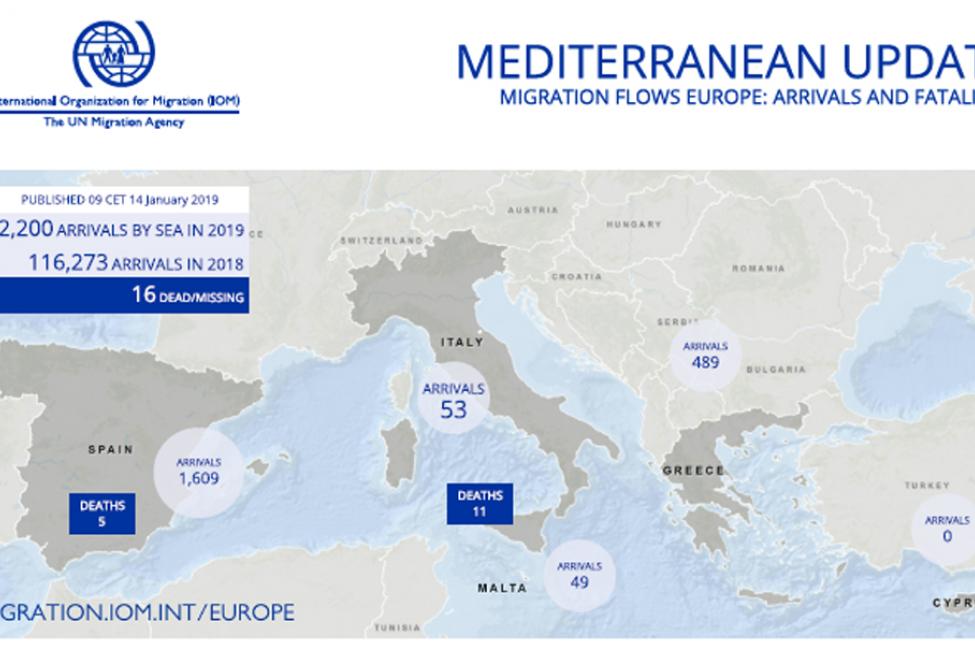-
Who we are
WHO WE AREThe International Organization for Migration (IOM) is part of the United Nations System as the leading inter-governmental organization promoting since 1951 humane and orderly migration for the benefit of all, with 175 member states and a presence in 171 countries.
-
Our Work
Our WorkAs the leading inter-governmental organization promoting since 1951 humane and orderly migration, IOM plays a key role to support the achievement of the 2030 Agenda through different areas of intervention that connect both humanitarian assistance and sustainable development.
What We Do
What We Do
Partnerships
Partnerships
Highlights
Highlights
- Where we work
-
Take Action
Take Action
Work with us
Work with us
Get involved
Get involved
- Data and Research
- 2030 Agenda
Mediterranean Migrant Arrivals Reach 2,200 in 2019; Deaths Reach 16
Geneva – IOM, the UN Migration Agency, reports that 2,200 migrants and refugees have entered Europe by sea through the first 13 days of 2019, a slight increase over the 1,915 arriving during the same period last year. Deaths on the three main Mediterranean Sea routes through almost two weeks of the new year are at 16 individuals, compared with 194 deaths during the same period in 2018. At this point in 2017 a total of 1,159 irregular migrants or refugees had landed in either Greece, Spain or Italy after crossing the Mediterranean, and IOM had recorded a total of 12 deaths.
The sharp spike in deaths at this time last year was due to a spate of shipwrecks off Libya. A year ago, IOM reported that Libyan Navy sources on 9 January confirmed at least 100 migrants remained missing in the third deadly shipwreck on the Mediterranean Sea since 6 January. IOM had already reported that day a total of 81 Mediterranean Sea deaths of migrants or refugees were recorded in the first eight days of the year.
Five of those deaths were in Western Mediterranean waters off Spain and Morocco. The rest – 76 with a possibility of many more – were recorded in the waters between Italy and Libya. In that last incident on the Central Mediterranean route, three rubber boats with 279 migrants (19 women, 243 men, 13 boys and four girls) were rescued by the Libyan Coast Guard, whose rescue operation lasted at least 12 hours.
Most recently, the remains of five people were recovered by the Libyan Red Crescent on the shores of Sirte, Libya on 13 January 2019. IOM’s Missing Migrants Project (MMP) team is verifying additional reports of bodies washing up on Libyan shores since 2 January.
On the Western Mediterranean route, the remains of a man thought to be a migrant were discovered near Cabo de Sabinar, in Spain’s southern province of Almería, on 5 January. This is the third body recovered on Spanish shores this year which is not connected to any known shipwreck. In Nador, Morocco, the remains of a woman were recovered from waters near Beni Ensar on 11 January, along with six survivors suffering from severe fuel burns.
IOM Italy
IOM Rome’s Flavio Di Giacomo on Monday noted that according to official Ministry of Interior figures, 53 migrants have arrived by sea to Italy as irregular arrivals through the first 13 days of 2019. That’s a decrease of 93.7% over the same period last year (see chart 1).
IOM Spain
IOM Spain’s Ana Dodevska reported that through Sunday (13 January) 1,609 men, women and children have arrived as irregular migrants this month, or more than the 1,400 arriving through all of January last year (see chart 2).
IOM Greece
IOM Greece’s Christine Nikolaidou reported on Monday that since 11 January the Hellenic Coast Guard (HCG) disclosed one incident requiring search and rescue operations off the island of Kos. The HCG rescued a total of 13 migrants and transferred them to that island.
Those 13 arrivals were among 139 IOM recorded in the four days between 10 and 13 January and bring to 489 the total number of sea arrivals to Greece this year (see chart 8.b).
Missing Migrants Project
2019 is the fifth year of IOM’s efforts to systematically record deaths on migration routes worldwide through its Missing Migrants Project. Since the beginning of 2014, the Project has recorded the deaths of 30,602 people, and yet due to the challenges of collecting information about these people and what happened to them, the true number of deaths during migration is likely much higher.
So far in 2019, Missing Migrants Project has recorded the deaths of 21 people (see chart below).
In addition to the deaths recorded on the Mediterranean, on 11 January a 26-year-old man of unidentified nationality was hit by a car when he was walking on the side of the 515 Highway connecting Caen and Ouistreham, France. Ouistreham is a port city in France’s province of Normandie with a cross-Channel ferry service to Portsmouth, UK. In 2018 IOM’s Missing Migrants Project reported there were 43 migrant deaths caused by vehicular accidents on Europe’s highways, and 12 more at various railway points.
In Mexico, Missing Migrants Project recorded the deaths of two individuals. In Mexico’s southern province of Veracruz, a 33-year-old man from El Salvador lost his life in a vehicle accident on 12 January. A day later (13 January), the Honduran Government reported the death of a 23-year-old Honduran national in a hospital in Saltillo, Coahuila. He was critically injured after being hit by a freight train several weeks before, on his journey north to the United States. There were 39 train-related deaths of migrants in Mexico last year.
